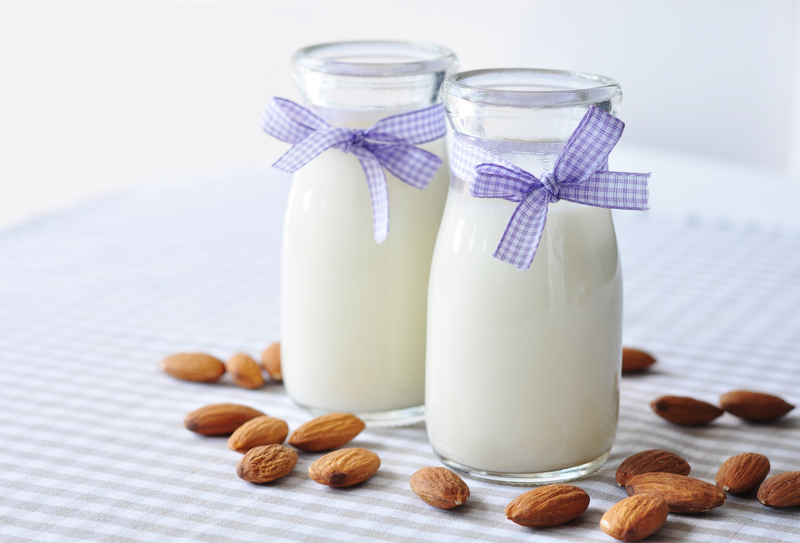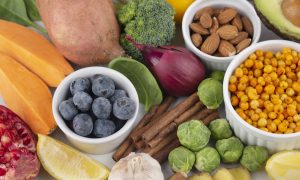Sales of plant-based milks such as almond, soy and coconut are skyrocketing globally, while sales of cow’s milk continue to decline1,2. Cow’s milk has historically been considered nature’s perfect food, but that idea is now being carefully reconsidered. As a dietitian with almost 10 years in the field of nutrition, I recommend dancers consider decreasing their dairy intake and use plant-based milks as alternatives because of growing concerns over cow’s milk and because it’s easy to get all the nutrients you need through plant-based milks and a healthy overall diet. Here’s why.
Bone-building vitamins.
With stress fractures being one of the most common injuries for dancers, it makes sense to place emphasis on adequate consumption of bone-building nutrients such as calcium, phosphorus, vitamins D and K. Certainly, cow’s milk has bone-building nutrients, but those are available in other foods, too.
Almond milk: One cup of almond milk actually has 516 mg calcium, while cow’s milk has 350 mg3. It’s also a good source of vitamin E and is often fortified with vitamin D. At only 40 calories and 3 grams of fat for non-sweetened, it’s a good option for dancers.
Soy milk: Good source of calcium and vitamin D.
Cow’s milk: Good source of calcium, vitamin D and phosphorus. Phosphorus can also be obtained in whole grains, beans, peas and nuts4.
All bone-building nutrients can be obtained in adequate amounts without drinking milk from a cow as long as the diet contains a variety of plant-based milks, grains, beans, peas, nuts, seeds, and of course lots of vegetables and leafy greens. Vitamin K is too often overlooked as a player in bone health. Vitamin K and calcium are both found in leafy greens. Plants like broccoli, cauliflower and soy also contribute to total calcium intake2. Since vitamin D deficiencies are common, I will often recommend that my dancer clients take a vitamin D supplement daily of approximately 1,000 IU per day (dose varies widely based on age and personal needs). Vitamin D plays an important role in the absorption of both calcium and phosphorus, but it’s more than just a bone vitamin. It also acts as a hormone, plays a role in immune function, and deficiencies can decrease muscle strength.
Protein content.
One cup of cow’s milk and soy milk have about the same amount of protein (8-10 grams)3. Other plant-based milks such as almond, cashew, rice or coconut don’t have much protein. There are, however, many ways to get adequate protein in the diet besides milk, and in my experience, it is rare to see dancers who are protein deficient. Studies show that Americans consume far more protein than they need, so drinking cow’s milk specifically to boost protein intake or using whey protein (from cow’s milk) supplements is not necessary for the vast majority of people8,11. If a dancer does need to supplement protein, I recommend pea or hemp seed protein in place of whey.
Soy’s isoflavones and cancer prevention.
Soy products do not have estrogen. Soy does have genistein, a naturally occurring isoflavone that has a chemical structure similar to estrogen. Instead of elevating cancer risk, however, it actually decreases cancer risk. Genistein has also been shown to have neuroprotective effects. Epidemiological studies show that populations that consume larger amounts of soy, such as many Asian countries, have significantly lower rates of breast and colon cancer than Western countries that consume less soy but more dairy5,6,8. It’s an Internet myth that soy has hormones. Cow’s milk, however, does have naturally occurring hormones.
Concerns about cow’s milk: Hormones and casein.
Researchers have highlighted some serious concerns over bovine/cow’s milk.
- Naturally occurring hormones present in cow’s milk such as estrogen and insulin like growth factor-1 are potential factors in cancers of the breast, prostate, ovarian and endometrial tumors5,6,7. Because these hormones are more present in milk fat, skim milk has lower concentrations of them. Plant-based milks have none.
- The protein casein that occurs naturally in cow’s milk has been linked to increased risk of cancer and autoimmune disease7,8,9,10.” Cow’s milk is thought to be an environmental trigger for autoimmune response in Type 1 diabetes”10.
- The Internet is full of dangerous misinformation about raw milk. Raw milk has been shown to contain dangerous microorganisms including e.coli 0157:H7 and salmonella that can cause serious illness or even death, particularly in children. Raw milk does not contain more nutrients, does not cure lactose intolerance, nor is it a treatment for asthma or allergies. Keep all milks refrigerated.
Potential for allergies or intolerances.
Dairy, soy and nuts are all on the list of the top seven allergens, so any of the milks have the potential to cause a mild or possibly severe allergic reaction in sensitive individuals. An intolerance is bloating or gastrointestinal pain resulting from poor digestion of the dairy milk sugar lactose. Plant-based milks do not contain lactose.
Animal welfare.
There is a growing awareness of the animal abuses common in the commercial dairy industry. Cows only produce milk when pregnant or immediately after giving birth to a calf. Therefore, cows are repeatedly impregnated and their babies are taken from them within minutes or hours after birth, which is exceedingly traumatic for both mother and calf. Male calves are sold for beef or veal. Mastitis is a painful inflammation of the udder or milk duct and requires antibiotics to treat.
By Emily C. Harrison MS, RD, LD of Dancer Nutrition.
 Emily Cook Harrison MS, RD, LD
Emily Cook Harrison MS, RD, LD
Emily is a registered dietitian and holds both a bachelor’s and master’s degree in nutrition from Georgia State University. Her master’s thesis research was on elite level ballet dancers and nutrition and she has experience providing nutrition services for weight management, sports nutrition, disordered eating, disease prevention, and food allergies. Emily was a professional dancer for eleven years with the Atlanta Ballet and several other companies. She is a dance educator and the mother of two young children. She now runs the Centre for Dance Nutrition and Healthy Lifestyles. She can be reached at emily@dancernutrition.com
www.dancernutrition.com
Sources:
- http://www.dairyreporter.com/Markets/Non-dairy-milk-market-vs.-dairy-milk-market-Mintel-market-research
- Big Business Identifies Appetite for Plant Based Milk. https://www.ft.com/content/7df72c04-491a-11e6-8d68-72e9211e86ab
- USDA Database for Standard Reference 2017 https://ndb.nal.usda.gov/ndb/search/list
- Gropper S, Smith JL, Groff JL. Advanced Nutrition and Human Metabolism. Thomson Wadsworth 2005.
- Malekinejad H, Rezabakhsh A. Hormones in dairy foods and their impact on public health- A narrative review article. Iran J Public Health. June 2015.
- Shaw J. Modern Milk. Harvard Magazine May/ June 2007.
- Milk and Prostate Cancer: The Evidence Mounts. Physicians Committee for Responsible Medicine. 2017. http://www.pcrm.org/health/health-topics/milk-and-prostate-cancer-the-evidence-mounts
- Campbell TC. The China Study. BenBella Books 2006.
- Lanou AJ. Should dairy be recommended as part of a healthy vegetarian diet? The American Journal of Clinical Nutrition. 2009. http://ajcn.nutrition.org/content/89/5/1638S.full.pdf+html
- Monetini L, et al. Antibodies to bovine beta-casein in diabetes and other autoimmune diseases. Hormone and Metabolic Research. 2002. https://www.thieme-connect.com/DOI/DOI?10.1055/s-2002-33595
- Davis, G. Proteinaholic. Harper Collins 2015.















